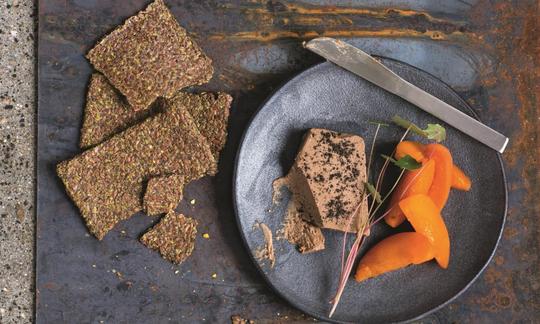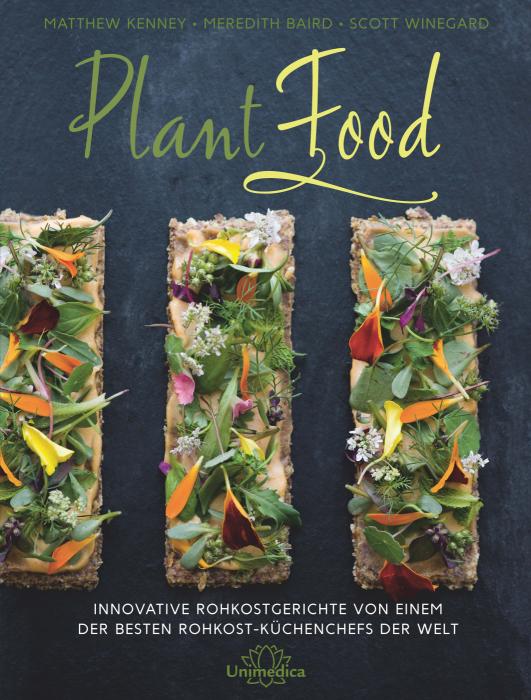Mushroom Pâté. Apricots. Mustard Herb Crackers.
vegan
Ingredients (for servings, )
| For the mushroom pâte | |
|---|---|
| 1 ¼ oz | Oyster mushrooms, raw (oyster mushrooms, organic?) |
| 1 ¼ oz | Cultivated mushrooms, raw (organic?) |
| 1 ¼ oz | Shiitake mushrooms, raw (Pasania mushrooms, organic?) |
| 2 ⅓ oz | Walnuts (tree nuts), raw (organic?) |
| 1 oz | Porcini mushroom powder, raw? (organic?) |
| ½ tbsp | Agave syrup (agave syrup, raw?, organic?) (0.21 oz) |
| ½ tbsp | Soy sauce (tamari, organic? raw?) (0.32 oz) |
| ½ tbsp | Agar-agar (organic?, raw?) (0.15 oz) |
| ½ tbsp | Sesame oil, raw? organic? (0.24 oz) |
| For the spicy apricots | |
| ½ tsp | Ginger, raw (organic?) (0.04 oz) |
| ½ tbsp | Apple cider vinegar (raw?, organic?) (0.26 oz) |
| 2 ⅞ oz | Apricots, raw (organic?) |
| ½ tsp | Thyme, raw (organic?) (0.01 oz) |
| For the mustard herb crackers | |
| 2 ⅔ oz | Linseed, raw, organic? (golden linseed, flax) |
| ½ oz | Mustard powder, mustard flour (raw?, organic?) |
| ⅛ oz | Thyme, dried, raw?, organic? |
| 65 ml | Drinking water, raw (organic?) (2.3 oz) |
Equipment
- dehydrator or oven
- blender
- grater
- refrigerator
- terrine dish (pâte dish)
Type of preparation
- dehydrate
- chop or grind
- blend
- cool
- grate (shred)
- marinate
Preparation
For the mushroom pâte
Blend all of the ingredients in a high-speed blender (the authors use the Blendtec soup/syrup setting and let it run three times). The mixture has to achieve a certain temperature in order to activate the agar-agar.The authors use a mixture of button, oyster, and shiitake mushrooms. However, you can also use just one of the mushroom varieties listed.
Pour the mixture into a terrine dish and let cool in the refrigerator for 2 hours, until firm.
For the spicy apricots
Grate the ginger and then combine all of the ingredients in a small bowl. Marinate at least 1 hour before serving.The original recipe calls for “Apfelweinessig” (Apple wine vinegar). If this isn’t available, then you can use “Apfelessig” (Apple cider vinegar) as we have listed in our recipe. It is not entirely clear what the difference between these two products is since apple cider vinegar is produced by fermenting apple wine.
For the mustard herb crackers
Blend all of the ingredients in a high-speed blender.The original recipe calls for mixed herbs. However, you can choose the herbs according to your taste preferences and availability.
Spread the mixture on Teflex sheets, cut into 5 x 7.5 cm rectangles, and dehydrate at 46 °C for 12 hours (or until dry and crisp).
Instead of the Teflex sheets, you can also use parchment paper.Strict raw foodists can spread the mixture on the Teflex sheets or parchment paper and dehydrate in a dehydrator at 42 °C.
Serving
Carefully turn out the pâte onto a large plate. Cut the pâte into slices that are about 2.5 cm thick. Serve with the crackers and apricots.
|
Nutritional Information per person
Convert per 100g
|
2000 kcal | |
|---|---|---|
| Energy | 197 kcal | 9.9% |
| Fat/Lipids | 15 g | 21.1% |
| Saturated Fats | 1.4 g | 7.0% |
| Carbohydrates (inc.dietary fiber) | 13 g | 4.9% |
| Sugars | 3.0 g | 3.4% |
| Fiber | 6.5 g | 25.9% |
| Protein/Albumin | 7.1 g | 14.2% |
| Cooking Salt (Na:92.4 mg) | 235 mg | 9.8% |
| Essential micronutrients with the highest proportions | per person | 2000 kcal | |
|---|---|---|---|
| Fat | Alpha-Linolenic acid; ALA; 18:3 omega-3 | 3.9 g | 197.0% |
| Min | Copper, Cu | 0.59 mg | 59.0% |
| Fat | Linoleic acid; LA; 18:2 omega-6 | 5.6 g | 56.0% |
| Min | Manganese, Mn | 0.92 mg | 46.0% |
| Prot | Tryptophan (Trp, W) | 0.09 g | 35.0% |
| Vit | Vitamin B7 (Biotin, ex vitamin H) | 17 µg | 34.0% |
| Elem | Phosphorus, P | 233 mg | 33.0% |
| Vit | Vitamin K | 25 µg | 33.0% |
| Vit | Vitamin B1 (Thiamine) | 0.33 mg | 30.0% |
| Prot | Threonine (Thr, T, irreversibly transaminated) | 0.26 g | 28.0% |
Detailed Nutritional Information per Person for this Recipe
The majority of the nutritional information comes from the USDA (US Department of Agriculture). This means that the information for natural products is often incomplete or only given within broader categories, whereas in most cases products made from these have more complete information displayed.
If we take flaxseed, for example, the important essential amino acid ALA (omega-3) is only included in an overarching category whereas for flaxseed oil ALA is listed specifically. In time, we will be able to change this, but it will require a lot of work. An “i” appears behind ingredients that have been adjusted and an explanation appears when you hover over this symbol.
For Erb Muesli, the original calculations resulted in 48 % of the daily requirement of ALA — but with the correction, we see that the muesli actually covers >100 % of the necessary recommendation for the omega-3 fatty acid ALA. Our goal is to eventually be able to compare the nutritional value of our recipes with those that are used in conventional western lifestyles.
| Essential fatty acids | per person | 2000 kcal |
|---|---|---|
| Alpha-Linolenic acid; ALA; 18:3 omega-3 | 3.9 g | 197.0% |
| Linoleic acid; LA; 18:2 omega-6 | 5.6 g | 56.0% |
| Essential amino acids | per person | 2000 kcal |
|---|---|---|
| Tryptophan (Trp, W) | 0.09 g | 35.0% |
| Threonine (Thr, T, irreversibly transaminated) | 0.26 g | 28.0% |
| Isoleucine (Ile, I) | 0.30 g | 24.0% |
| Valin (Val, V) | 0.35 g | 22.0% |
| Leucine (Leu, L) | 0.45 g | 19.0% |
| Phenylalanine (Phe, F) | 0.30 g | 19.0% |
| Lysine (Lys, K, irreversibly transaminated) | 0.34 g | 18.0% |
| Methionine (Met, M) | 0.11 g | 11.0% |
| Vitamins | per person | 2000 kcal |
|---|---|---|
| Vitamin B7 (Biotin, ex vitamin H) | 17 µg | 34.0% |
| Vitamin K | 25 µg | 33.0% |
| Vitamin B1 (Thiamine) | 0.33 mg | 30.0% |
| Vitamin B3 (Niacin) | 4.4 mg | 27.0% |
| Vitamin B5 (Pantothenic acid) | 1.5 mg | 25.0% |
| Vitamin B9, B11 (Folate, as the active form of folic acid) | 45 µg | 23.0% |
| Vitamin B2 (Riboflavin) | 0.29 mg | 21.0% |
| Vitamin B6 (pyridoxine) | 0.21 mg | 15.0% |
| Vitamin C (ascorbic acid) | 3.8 mg | 5.0% |
| Vitamin E, as a-TEs | 0.54 mg | 4.0% |
| Vitamin A, as RAE | 21 µg | 3.0% |
| Vitamin D | 0.08 µg | 2.0% |
| Vitamin B12 (Cobalamin) | 0.00 µg | < 0.1% |
| Essential macroelements (macronutrients) | per person | 2000 kcal |
|---|---|---|
| Phosphorus, P | 233 mg | 33.0% |
| Magnesium, Mg | 95 mg | 25.0% |
| Potassium, K | 445 mg | 22.0% |
| Sodium, Na | 92 mg | 12.0% |
| Calcium, Ca | 79 mg | 10.0% |
| Essential trace elements (micronutrients) | per person | 2000 kcal |
|---|---|---|
| Copper, Cu | 0.59 mg | 59.0% |
| Manganese, Mn | 0.92 mg | 46.0% |
| Iron, Fe | 3.3 mg | 23.0% |
| Selenium, Se | 10 µg | 18.0% |
| Zinc, Zn | 1.6 mg | 16.0% |
| Iod, I (Jod, J) | 13 µg | 8.0% |
| Fluorine, F | 18 µg | 1.0% |
Narayana Verlag GmbH /Unimedica Verlag , Matthew Kenney
Raw recipes 39 (1), Cooked recipes 32 (2)
Additional photos (6)
"The book Plant Food embodies the art of culinary art. Whether you want to actually try the recipes or just gain a visual experience."
Since this book is written in German, a description is omitted here. If you are interested, please switch to German in the menu.
This mushroom pâte with spicy apricots and mustard herb crackers is an elegant and artistic dish that will impress your guests every time.
Serving size: The original recipe was designed to serve 12 people. We have cut the ingredients in half and changed the number of servings to 6.
Which step should you begin with?: This recipe can be started in two different ways. You can either follow the steps of the original recipe, as we have described here, or you can start by making the Mustard Herb Crackers. The crackers take the longest to make, but can be dehydrated overnight. It doesn’t take too long to marinade the apricots and it works well to refrigerate the mushroom pâte overnight for 10 hours so that it has long enough to set up.
Raw food or rather cooked food?: We have categorized this recipe as a cooked dish since the Mustard Herb Crackers are heated at temperatures above 42 °C. If you are not a strict raw foodist, you can use the temperature listed or dehydrate the crackers in the oven. In the latter case, set the temperature as low as possible (usually 50 °C) and leave the oven open a crack.
Storage: Ginger can be sliced and then stored in the freezer. This way larger quantities you buy will stay good for a longer period of time.
Freshly ground mustard powder: Many processed powders contain 80 % ground mustard, but they also include added herbs and wheat flour. The latter binds the powder better when it is added to foods and depending on the amount used may influence the thickness of the sauce. However, if you have mustard seeds, you can grind these in an electric coffee grinder or between two smooth surfaces. Depending on the seeds the powder contains, it will be somewhat hotter (brown or black seeds) or milder (yellow seeds).
Degree of hotness: To test how hot the mustard powder is, you can mix a smaller amount with a liquid such as water. The enzyme myrosinase contained in the mustard seeds is only activated when it comes into contact with liquids. This enzyme turns the glucosinolates into various isothiocyanate compounds, which are frequently called “mustard oil.” This is the reason why mustard seeds don’t release flavor until they are chewed and table mustard containing water, on the other hand, is hot from the beginning.
Mushrooms for the pâte: The original recipe calls for a mixture of button, oyster, and shiitake mushrooms. However, you can also use just one of the mushroom varieties listed or another type that you prefer.
Thyme or additional herbs: In place of the mixed herbs, you can use only thyme or other herb(s) of your preference that you may even have in your garden.




